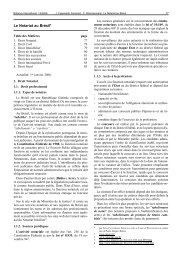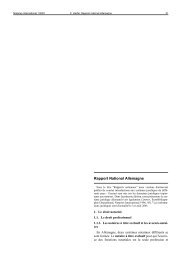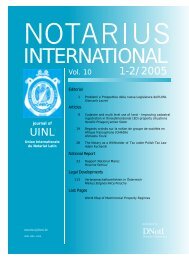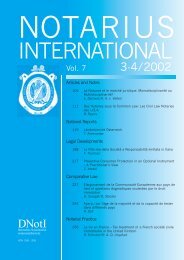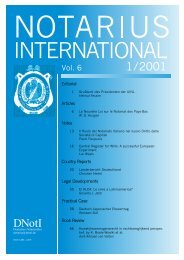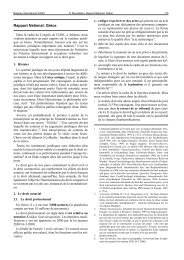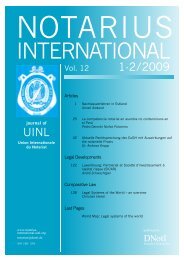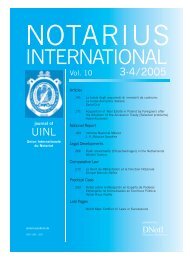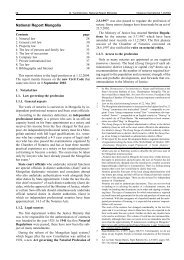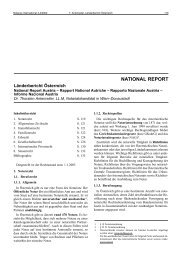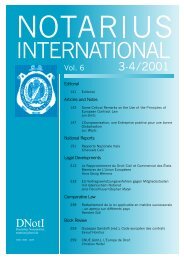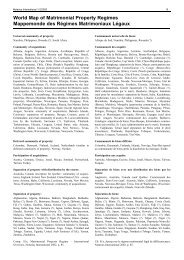National Report Mexico - Notarius International
National Report Mexico - Notarius International
National Report Mexico - Notarius International
Create successful ePaper yourself
Turn your PDF publications into a flip-book with our unique Google optimized e-Paper software.
202 J. A. Márquez González, <strong>National</strong> <strong>Report</strong> <strong>Mexico</strong> <strong>Notarius</strong> <strong>International</strong> 3-4/2005<br />
- Proof of facts and accreditation of rights;<br />
- Accreditation of residence, good conduct or financial<br />
dependence;<br />
- Verification of possession of a real right;<br />
- Voluntary change of name;<br />
- Voluntary procedure for survey and demarcation;<br />
- Voluntary creation and cancellation of family property;<br />
- Voluntary liquidation of property held jointly by spouses;<br />
- Voluntary creation and amendment of marriage contracts;<br />
- Testate or intestate succession, and<br />
- Unanimous waiver and appointment of executor (article<br />
699-A of the Code of Civil Procedure of Veracruz).<br />
1.6. Procedure for execution<br />
1.6.1. Execution<br />
Articles 100-142 of the Notary Law describe in detail<br />
the procedure for notarial execution. Thus, deeds must be<br />
issued on indelible media with no abbreviations, except<br />
in the case of transcripts. No numbers must be written unless<br />
they are also stated in words and unused space must<br />
be crossed through. Corrections may be made using the<br />
method of writing between the lines, indicating the incorrect<br />
expression by means of a line, but in any case finally<br />
saving what is corrected. Changes and crossings out<br />
are strictly prohibited.<br />
The notary must draft deeds in Spanish, although in<br />
exceptional circumstances he may enter words in another<br />
language. He must state the place and the date, the full<br />
names of the appearers and the legal name of the act. He<br />
must also carefully record the antecedents, listing the respective<br />
titles of ownership, as appropriate, the registration<br />
particulars and the necessary administrative and tax<br />
documents. Likewise, he must describe the property or<br />
subject-matter of the business, as appropriate, in detail,<br />
list the powers or authorities for representation, draft in<br />
order the clauses agreed by the signatories and any waivers<br />
of rights. He must attach any documents that he<br />
deems important to the appendix and he must certify and<br />
attest that he knows the signatories (stating their general<br />
particulars), that he has assured himself of their identity,<br />
that he read the deed out to them and that he explained<br />
its legal scope to them. He must also certify the facts<br />
placed before him. He must do all this in clear, concise,<br />
precise legal language, with no obsolete or antiquated<br />
words or formulae. At the end of the deed, the notary<br />
must obtain the signatures or marks of the signatories and<br />
appearers and witness the deed with his signature, his<br />
stamp and the expression “Ante mí” (Before me).<br />
1.6.2. Open or closed record<br />
When a document has been drafted, it is issued on folios<br />
or in books authorised by the local government, either<br />
in the form of an “open” record or a “closed” record.<br />
The folios making up the “open” record have a consecutive<br />
identification number and are subject to documentary<br />
security procedures consisting of watermarks or other<br />
distinctive marks.<br />
There is currently a decisive movement towards legislative<br />
reform in favour of “open” records. A total of 21 federal<br />
states now contemplate these records in their legislation<br />
as being either obligatory or optional and 11 states do<br />
not, although we should point out that 4 of them possess<br />
the record known as the “special open” record for executing<br />
deeds for immovable properties of “social interest”<br />
which other federal states have abolished, precisely to introduce<br />
the “open” protocol in a generalised manner.<br />
Interested parties have the right to obtain transcripts,<br />
certified reproductions and certificates of the document<br />
from the notary of either the full document or part thereof,<br />
provided that no damage ensues in this latter case. The<br />
transcripts executed by notaries are subject to security<br />
procedures on one cover, which identifies the notary, the<br />
number of his notary public's office, the respective jurisdiction<br />
and the local government to which it belongs. It is<br />
also common for the cover to show the notary's private<br />
logotype or letterhead. In turn, it is mandatory for the<br />
printed sheets of transcripts to bear the seal and the signature<br />
or paraph of the notary and, in some cases, the respective<br />
kinegram. 3<br />
1.6.3. Public documents<br />
Public documents are documents that a public official<br />
who has been granted the authority to attest documents is<br />
authorised by law to draft, within the limit of his powers.<br />
Public documents are also those documents issued by<br />
public officials when discharging their duties. The classification<br />
of public is shown by the fact the document bears<br />
regular stamps, signatures or other external signs provided<br />
by law, as appropriate (article 129 of the Federal Code<br />
of Civil Procedure).<br />
1.7. Notaries' tariffs<br />
There is no applicable general system of notaries' tariffs.<br />
In fact, such a system is established in few federal<br />
states, including the Federal District and Veracruz. It may<br />
be that in other states it is provided by law and although<br />
it has actually been issued, in practice it is meaningless<br />
either due to its age or because of the complexity of its<br />
application or because it is out of date due to the recent<br />
financial inflation in <strong>Mexico</strong>.<br />
1.8. Professional organisations<br />
Most of the notarial laws in the Republic of <strong>Mexico</strong><br />
contemplate an association as an institution that obligatorily<br />
groups together all the notaries in the federal state.<br />
From a national perspective, the association known as<br />
the Asociación Nacional del Notariado Mexicano<br />
(ANNM) 4 (<strong>National</strong> Association of Mexican Notaries)<br />
was founded in 1955. All of the notariates in the country<br />
3 The new notarial laws of Veracruz, Tabasco and Nayarit already require<br />
the use of the kinegram (article 136 of the Veracruz notarial<br />
law) or hologram (article 40 of the Tabasco notarial law and article<br />
148 of the Nayarit notarial law).



